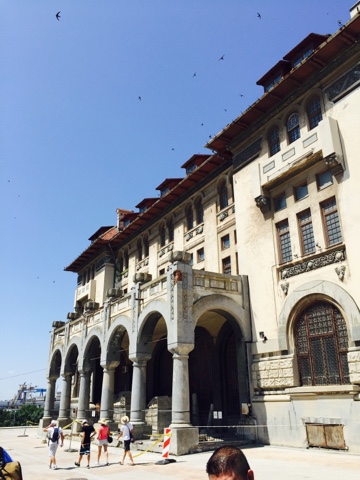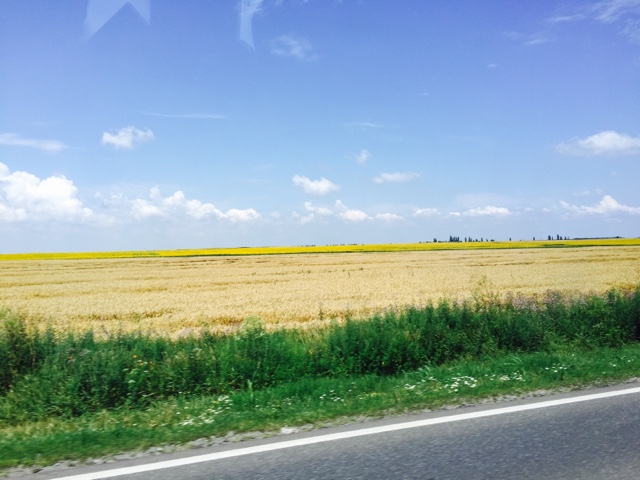Amsterdam...where everyone smokes!
Well, everyone smokes something, ha.
Today I left small little Haarlem (who Rick Steves does NOT give enough credit to) and made my way to the city, much more successfully than when I left it yesterday, might I add. I booked a walking tour with SANDEMANs Tours, completely free, and we were to meet at Dam Square at 10AM. After maneuvering my way through the train system and down the busy busy Amsterdam street, I made it to my little Scottish tour guide. Then, I made a friend. Jessie popped up beside me and said rather bluntly, "Do you speak English?" I replied, "Yes! And I'm so glad you do, too!" For the rest of the day into the afternoon we were travel buddies. Her Pittsburgh, PA self was quite fun and so was her story. She is currently an Au Pair in Naples, Italy, and while her family is on vacation she decided to visit Amsterdam and Barcelona, spending five days indulging herself in other cities. I'm quite glad she did.
Our tour started behind the National Monument located on one side of Dam Square (the other side is currently occupied by the International Beach Volleyball World Cup. Who knew?) through a small alleyway to get away from the crowds. He began with a brief history of the Netherlands, which I'll recount to you as I show pictures and made my way through the city.
1280: Amstel river runs through the current Dam Square; a dam is built by a merchant
This is where Amsterdam gets its name. Creative, eh?
However, in order to convince people to move to a city with no industry and build the canals the merchant wanted so he could open a trade route to the city, he needed to come up with an incentive. Then, people visited places of holy significance; no such thing as a vacation! So, a convenient "miracle" happened to a dying man. He was told by a priest to be sick into his fire place and when he does, the fire goes out. The next morning a piece of bread was there which he ate and he didn't die. Thus commence a pilgrimage to see this great fireplace and city!
Now, there was a population to build the canals of which the city is FAMOUS. Not to mention, they're quite beautiful. Jessie and I sat alongside one for quite a while today, beside the now famous "The Fault in our Stars" bench.
This is something like what our view was. These canals are really cool, and run all throughout the citty, earning it the nickname, "The Venice of the North"
So, in the 1500s, the Netherlands were incorportated into the Hapsburg empire, eventually fighting a war between the Dutch and Spanish because of this integration. After the 80 Years War (which lasted 80 years) was over, the Dutch had won themselves into a Republic that lasted until 1785. During this time, they built the enormous City Hall, the largest in the world, that later became the seat of Louis-Napoleon, Napoleon's younger brother when he ruled. It is currently the Royal Palace.
It was the time of the Republic, however, the caused the rise of Amsterdam, as the city was ahead of its time, tolerating different religions and philosophies by letting them live side by side without government persecution. It became economically prosperous and the site of many scientific advancements from the likes of Galileo, and flourishment in the arts from painters like Rembrandt and Van Gogh. The canals made trading possible, and their colony Indonesia led to much profit by the Dutch East India Trading Company as well. All was great. Then Napoleon came, bailed them out of an economic crunch after the trading went south, and the government was turned into a monarchy, which it is now, ruled by the House of Orange (you can imagine how many oranges are in the grocery stores. Wow.)
Then, of course, WWI comes and the country stayed neutral by selling weapons to both sides. Unfortunately, it wasn't as lucky with WWII, as is famously known by the story of Anne Frank.
I couldn't come to Amsterdam without visiting this house. So I bid Jessie farewell at her hostel and made my way to her father's factory, where the Secret Annexe is hidden. The line was an hour wait and that may seem like a lot for a museum, but oh it is so much more than that isn't it?
Anne's secret hideaway. Her story is amazing, inspiring, and so powerful in many ways. The optimism she shows, the courage she had while she was in hiding for two years is unbelievable. But i have an entirely new respect for it after actually being inside. It was small and dim. They had to be quiet the entire day long. I don't at all see how they did it for so long without being thoroughly depressed, but they did. Anne's may not have survived the Concentration Camp she eventually died in, but her story is certainly one of survival. After all, she wrote in her diary that she wanted to be a journalist someday and that she wanted "to go on living even after my death!" Little did she know her diary would be one of the most read pieces of literature in history. Such a remarkable story set in such a remarkable place.
Eventually, after the horrors of WWII were over, the economy prospered again in the 1960s, along with the cultural revolution and hippie movement. In Amsterdam, however, where tolerance has existed for centuries, these "free people" were no exception, and when the War on Drugs was happening in the US, it was happening here, with the exception of one thing - Cannabis. It is not, however, legal, just de-criminalized, so that they might crack down on the other hard drugs that needed to be controlled. Amsterdam, actually, was the number one city in the world for heroin addiction until this happened and it is now one of the lowest.
The law also made prostitution legal, an actual occupation, so that they might protect the women from sexual offenders. The Red Light District has been famous here for centuries, as it was a port city and many sailors made their way through here. Now, you can't take pictures, and the women open their window curtains when they're "in service." How interesting to be there and that to be an occupation that you register for in the city Court House.
After the economy rose again and it became a place for people to move to in droves for the freedoms allowed, gentrification started happening all around, and sanitizing of "grosser" parts of the city began. It is now much cleaner, safer and more desireable to come.
Other fun things I saw!
This is a famous church of the Beguine nuns, Catholic nuns who didn't take the official oath of the church yet still led simple lives. After the country went Protestant, their church was turned into the official Church of Scotland, and Protestants went here, including the Pilgrims. YEP, those Pilgrims! In fact, the stained glass in the back of the church is of them praying before they leave for the New World. There is one in the Boston State House of them praying after reaching it! SUPER COOL.
Last fun fact about Amsterdam if you're not already bored to tears by my post tonight. Sorry for the history garble. Anyways, a lot of the houses in the city lean fowards, some due to the fact they were built on sediment, but a lot of it was purposeful, so that the people could put furniture in their houses. They can't get it up the stairs because they're too narrow, so they throw a rope over the hook you can see in this picture and haul up whatever they need! Wonder how much those movers get paid?
Tomorow, you'll see more of Haarlem!







Comments
Post a Comment